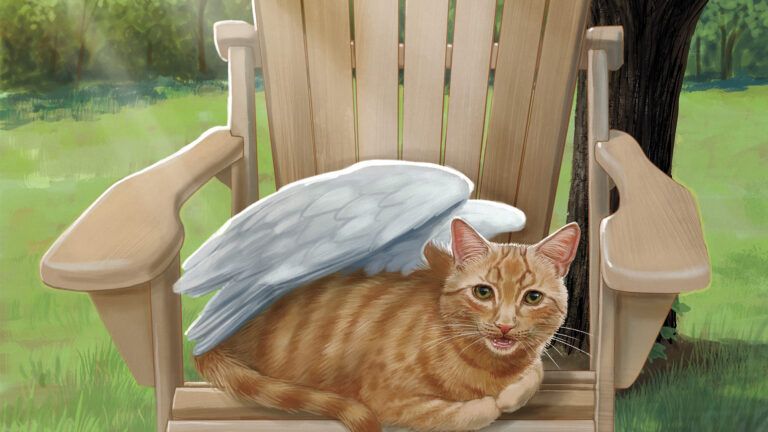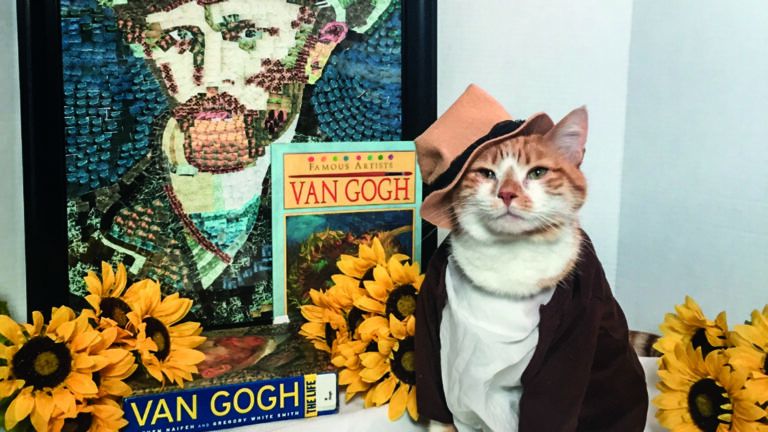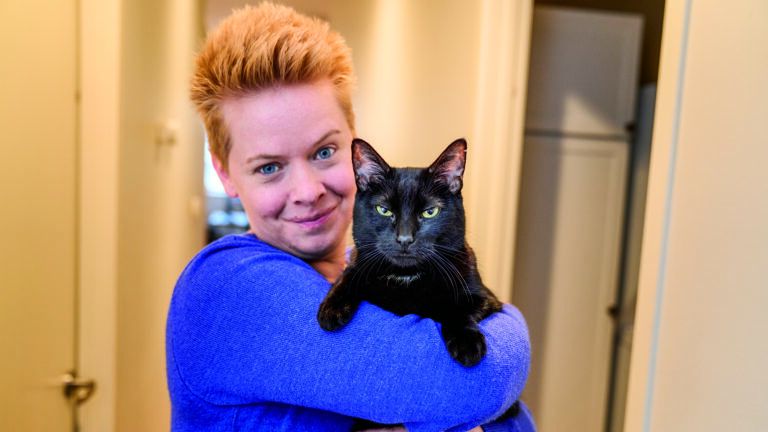Mornings in our household start with breakfast—for everyone. The gerbils, rabbits, goats, ponies, horse, chickens included. It’s a big job, but it goes quickly when you have help. My 10-year-old daughter, Iris, loves feeding the animals. She comes with me from pen to pen, her cat, Thula, at her heels.
Thula likes to perch on the fence and watch, though she’s a little too interested in chicks that have just hatched. But the large fluffy Maine coon cat is easy to keep an eye on, because she’s never far from Iris’s side. No matter how many animals join our family, I’ll always have a special place in my heart for Thula.
Iris Grace was born in 2009 and was, in my opinion, the most beautiful baby. Ten delicate fingers, ten tiny toes and the widest blue eyes. But those eyes always seemed to be looking elsewhere, never at me or my husband. Iris was there—but she wasn’t. It was as if she lived in her own world, separate from ours. When she turned two, we took her to a developmental specialist. It didn’t take long for the doctor to give us a diagnosis. Iris had severe autism.
The simplest things were a struggle. Iris had trouble speaking and could say only a few words. Doctors told us it was possible that she would never say more. She shied away from human contact. She hated wearing clothes because of the texture of the fabric. She didn’t like being in the car. She had trouble sleeping at night.
Bath time was the worst of all. Iris couldn’t stand water—the sound of it, the feel of it on her skin. She would scream when I washed her hair, flailing her arms and trying to climb out of the tub. It was heartbreaking and exhausting. I would lie awake in the middle of the night and cry. Will Iris stay locked in her own world? I’d wonder. What if she never connects with anyone, never knows joy and love? I didn’t want such a lonely life for my daughter.
The only thing that Iris seemed to take pleasure in was art. School was such an ordeal for her that we pulled her out of pre-K. I taught her at home instead. I tried to replicate as many school activities as I could. I even set up our own little art class, and Iris took to painting. She would spend hours, brush in hand, engrossed in her work. But even that was something she did alone.
I’d read that therapy animals can help children with autism. I loved horses and hoped to share that passion with my daughter. But they terrified her. Dogs weren’t any better. Even the calmest ones intruded on Iris’s personal space, upsetting her. I was losing hope that our little girl would ever interact with others.
Then came Christmas of 2014. We cared for my brother’s cat, an old tabby, over the holidays. The cat wasn’t loud. He didn’t jump on Iris or lick her. He just quietly shared his space with her—the perfect companion. When my brother took him back, I started the search for a cat of our own.
I had a few requirements. I wasn’t interested in a cat that would sleep all day and ignore Iris. I wanted to find a breed that was sociable, friendly and curious. I stumbled across Maine coons—an American breed known for its gentle nature, intelligence… and love of water. Bath time was such a struggle in our house. A water-loving cat seemed a little too good to be true. But a local Maine coon breeder I contacted assured me that that was the case. “These cats love to swim,” she said. She had a female kitten she thought would be right for Iris.
The day I brought the kitten home, I sat Iris down in the living room and said I had a surprise for her. Then I brought in the cat carrier. As soon as I opened the door, the kitten poked her head out. She was gorgeous, with fluffy brown striped fur and long tapered ears. She scanned the room with her intelligent green eyes, then made a beeline for Iris. I held my breath. The kitten crawled into my daughter’s lap. Iris smiled, delighted. Their connection was instant. Magical. From that moment on, the two were inseparable.
Though never trained as a service animal, it was as if Thula knew she had a job to do. And she took it seriously. Wherever Iris went, there was Thula. She watched as Iris painted, and she curled up by my daughter’s side when she read her picture books. Thula would sense when Iris was getting overwhelmed and soothe her. Thula even came along on bicycle and car rides. From the first night, she slept in Iris’s arms, as if she belonged there. I kept checking on them, but Iris slept peacefully through the night.
And, yes, our Maine coon loved water. The first time I filled up the bathtub after we got Thula, she jumped right in. Iris was worked up as usual, but seeing how much her cat liked the bath, she calmed down a bit. It took a few tries, but soon Iris was taking regular baths, Thula right in the water with her.
Thula never demanded anything from our little girl. She was simply there, offering love, comfort and acceptance. Iris started to open up and communicate. We’d had Thula for only a few months when one day I heard Iris say, “Sit, cat.” She patted the space on the couch next to her. And Thula sat. I heard more and more words. Iris even started expressing herself to me and my husband. I wanted to jump for joy when she told us that she was hungry or that she wanted to play outside.
It’s been six years since Thula joined us, and our lives look very different now. While they’re still the best of friends, Iris is able to go places without Thula. My daughter can make connections—with other animals and even children her own age. It’s as if Thula was a stepping stone in her development. And now, our Maine coon is helping other children with autism through the Little Explorers Activity Club. In 2018, I opened the nonprofit playgroup as a place for children on the autism spectrum to spend time with one another in a calming, nurturing environment. We have since expanded into an animal-therapy program, complete with staff and furry “counselors.”
On our property in Leicestershire, England, we offer animal-assisted therapy and animal-assisted learning. Thula is the ultimate therapy cat. There are games and activities, such as crafts and horseback riding, but there are also quiet areas and rooms where the children can go to relax if it all gets to be too much.
Watching Iris feed our pony Casper, I’m still amazed, because it’s a scene I wouldn’t have been able to imagine when she received her diagnosis. The change in my daughter is nothing short of a miracle, a miracle that began with a Maine coon cat named Thula.
Did you enjoy this story? Subscribe to All Creatures magazine.





